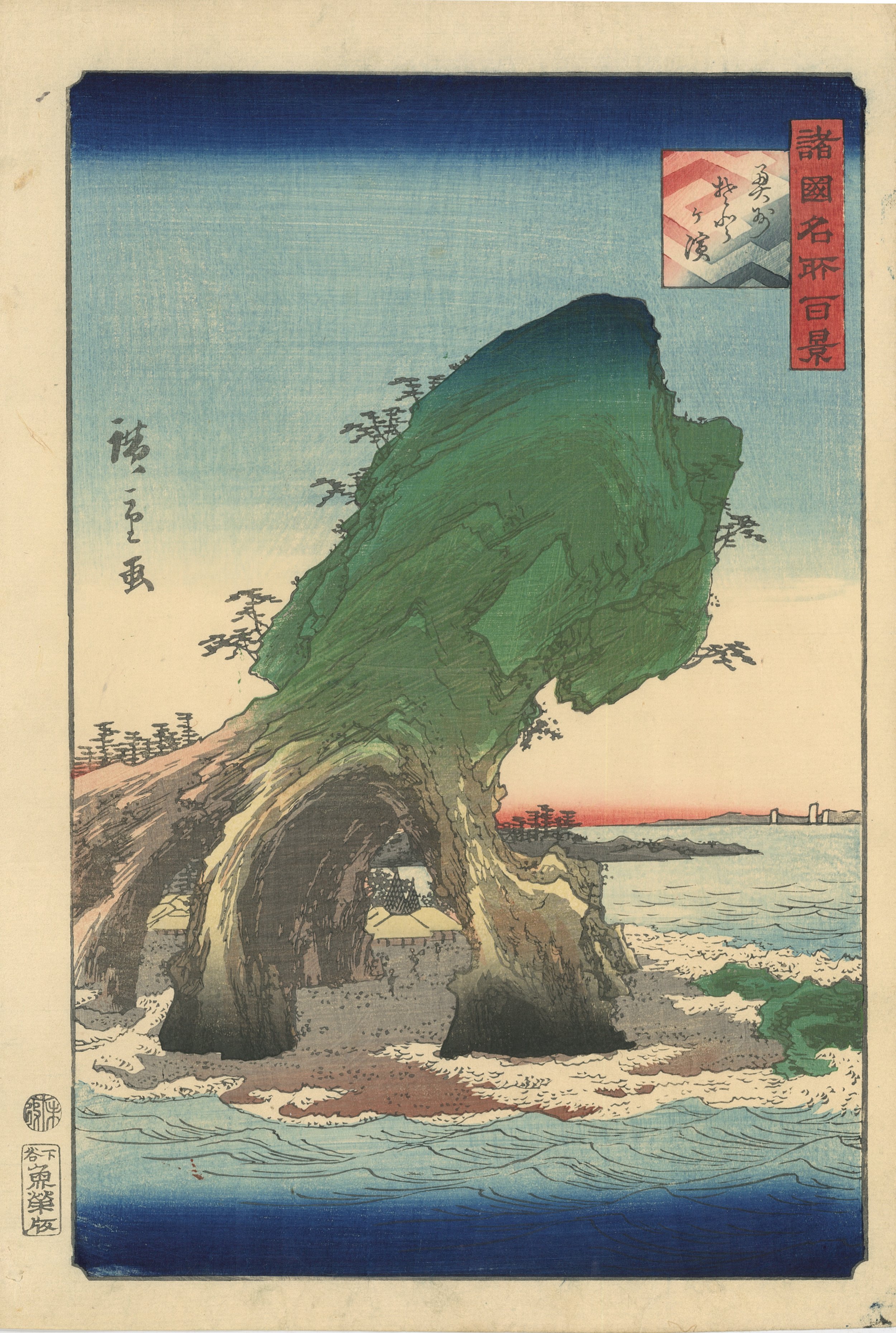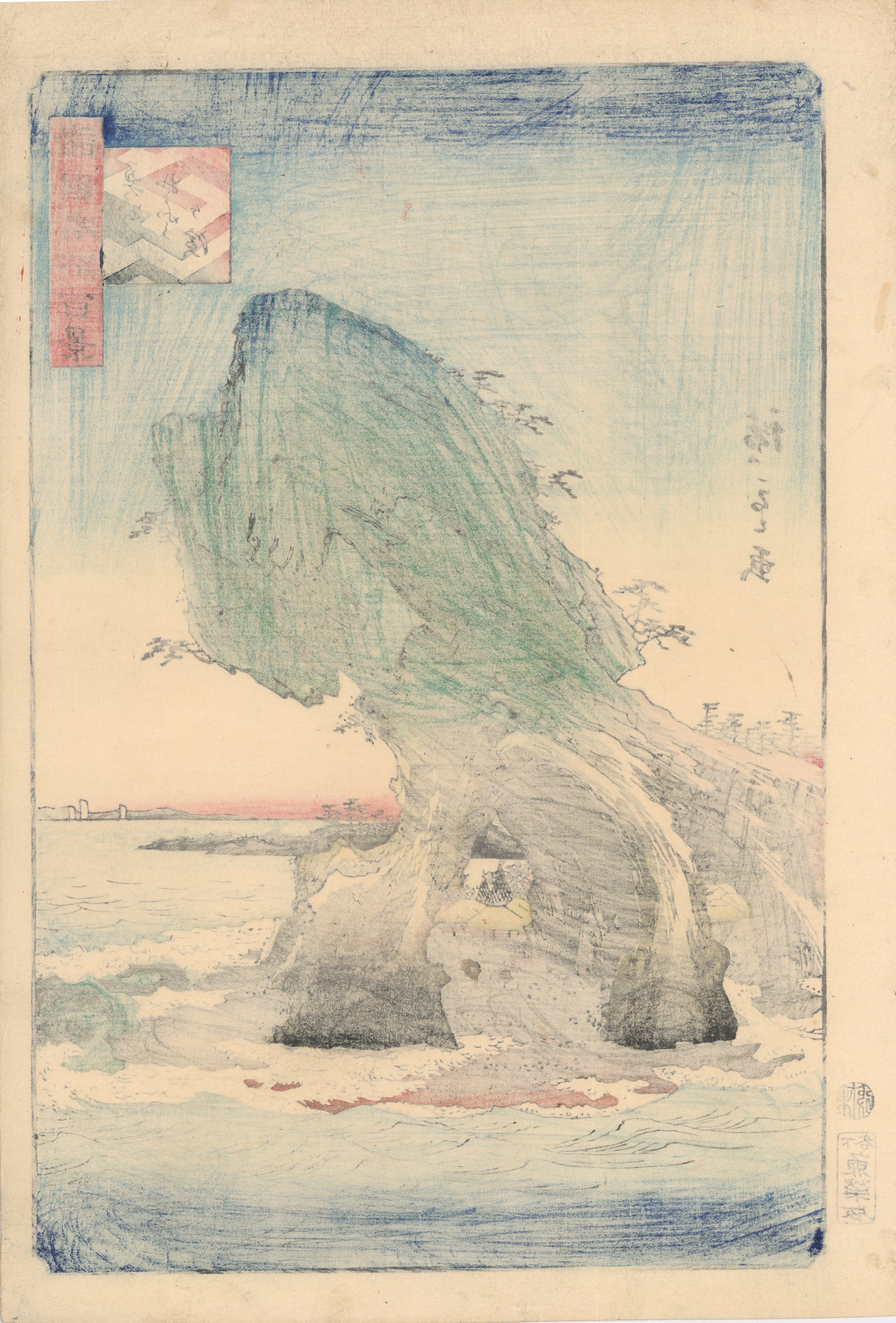Hiroshige II | Sotogahama in Oshu Province, 100 views of Famous Places in the Provinces
二代目歌川広重 Utagawa Hiroshige II (active 1826–1869)
诸国名所百景 奥州 外滨町
Sotogahama in Oshu Province, from the series One Hundred Views of Famous Places in the Provinces
1859
木版画 | 纵绘大判 | 37cm x 25.5cm
Woodblock-print | Oban tate-e | 37cm x 25.5cm
早期版次;颜色鲜艳;品相非常好;边缘完整
Fine impression, color and condition; full margin
$3,200
瞧,画中的石头好像大章鱼。
《诸国名所百景》,是二代歌川广重于1859至1861年创作的竖版名所绘系列,其出版商为出版过初代歌川广重《名所江户百景》的鱼屋荣吉。全系列据传共85幅(一说90幅),但目前得到确认的只有81幅。
奥州,即陆奥国,日本古令制国,旧国境约相当于今青森、岩手、宫城、福岛及秋田县东北部区域。其境内的外滨在古时常被认为是日本的最东端,因此也常被各类文艺作品作为母题。
在本作中,二代广重将外滨海滩的一处天然海蚀穴作为画面主体,用惹眼的青绿着重描绘其顶部的大块倾斜岩体,使其与下方如拱门的通道形成鲜明对比,整体结合起来,宛如一只正在海滩上张牙舞爪的大章鱼,极具视觉冲击力。透过它石质“腕足”间的缝隙,还能看到后方渔村内的几点如豆人影与排排茅草小屋,平静的犹如童话世界,不禁使人心生欢喜。
Hiroshige II’s "100 VIews of Famous Places in the Provinces" is considered a sequel of sorts to his predecessor’s storied “100 Famous Views of Edo,” with a similar format – vertical oban tate-e designs with square/rectangle cartouches on the upper right – and mission: showing famous spots for Japanese print buyers to collect. It was published by the same publisher, Uoya Eikichi. In all, 81 designs are known.
But the canvas was broader: he sought to portray sites from all over the nation, not just the capital. In this dramatic design, we travel the whole way to the northern most tip of the main Japanese island of Honshu from where, on a clear day, one can see Hokkaido. This was the northernmost part of Japan in Edo times.
The sea and wind were rough in this part of the world. Hiroshige II here focuses on a wonderfully bizarre natural cave on Sotohama Beach, with tiny villagers putting it all into scale for us. You can almost feel the cutting winds and smell the surf. Like many prints in this series, the printing is elaborate and exquisite, with generous and skillfully executed bokashi. In a wonderful touch, the sharp edges of the rocky outcropping are echoed in the cartouche’s striking zig-zag pattern.
Interested in purchasing?
Please contact us.
二代目歌川広重 Utagawa Hiroshige II (active 1826–1869)
诸国名所百景 奥州 外滨町
Sotogahama in Oshu Province, from the series One Hundred Views of Famous Places in the Provinces
1859
木版画 | 纵绘大判 | 37cm x 25.5cm
Woodblock-print | Oban tate-e | 37cm x 25.5cm
早期版次;颜色鲜艳;品相非常好;边缘完整
Fine impression, color and condition; full margin
$3,200
瞧,画中的石头好像大章鱼。
《诸国名所百景》,是二代歌川广重于1859至1861年创作的竖版名所绘系列,其出版商为出版过初代歌川广重《名所江户百景》的鱼屋荣吉。全系列据传共85幅(一说90幅),但目前得到确认的只有81幅。
奥州,即陆奥国,日本古令制国,旧国境约相当于今青森、岩手、宫城、福岛及秋田县东北部区域。其境内的外滨在古时常被认为是日本的最东端,因此也常被各类文艺作品作为母题。
在本作中,二代广重将外滨海滩的一处天然海蚀穴作为画面主体,用惹眼的青绿着重描绘其顶部的大块倾斜岩体,使其与下方如拱门的通道形成鲜明对比,整体结合起来,宛如一只正在海滩上张牙舞爪的大章鱼,极具视觉冲击力。透过它石质“腕足”间的缝隙,还能看到后方渔村内的几点如豆人影与排排茅草小屋,平静的犹如童话世界,不禁使人心生欢喜。
Hiroshige II’s "100 VIews of Famous Places in the Provinces" is considered a sequel of sorts to his predecessor’s storied “100 Famous Views of Edo,” with a similar format – vertical oban tate-e designs with square/rectangle cartouches on the upper right – and mission: showing famous spots for Japanese print buyers to collect. It was published by the same publisher, Uoya Eikichi. In all, 81 designs are known.
But the canvas was broader: he sought to portray sites from all over the nation, not just the capital. In this dramatic design, we travel the whole way to the northern most tip of the main Japanese island of Honshu from where, on a clear day, one can see Hokkaido. This was the northernmost part of Japan in Edo times.
The sea and wind were rough in this part of the world. Hiroshige II here focuses on a wonderfully bizarre natural cave on Sotohama Beach, with tiny villagers putting it all into scale for us. You can almost feel the cutting winds and smell the surf. Like many prints in this series, the printing is elaborate and exquisite, with generous and skillfully executed bokashi. In a wonderful touch, the sharp edges of the rocky outcropping are echoed in the cartouche’s striking zig-zag pattern.
Interested in purchasing?
Please contact us.
二代目歌川広重 Utagawa Hiroshige II (active 1826–1869)
诸国名所百景 奥州 外滨町
Sotogahama in Oshu Province, from the series One Hundred Views of Famous Places in the Provinces
1859
木版画 | 纵绘大判 | 37cm x 25.5cm
Woodblock-print | Oban tate-e | 37cm x 25.5cm
早期版次;颜色鲜艳;品相非常好;边缘完整
Fine impression, color and condition; full margin
$3,200
瞧,画中的石头好像大章鱼。
《诸国名所百景》,是二代歌川广重于1859至1861年创作的竖版名所绘系列,其出版商为出版过初代歌川广重《名所江户百景》的鱼屋荣吉。全系列据传共85幅(一说90幅),但目前得到确认的只有81幅。
奥州,即陆奥国,日本古令制国,旧国境约相当于今青森、岩手、宫城、福岛及秋田县东北部区域。其境内的外滨在古时常被认为是日本的最东端,因此也常被各类文艺作品作为母题。
在本作中,二代广重将外滨海滩的一处天然海蚀穴作为画面主体,用惹眼的青绿着重描绘其顶部的大块倾斜岩体,使其与下方如拱门的通道形成鲜明对比,整体结合起来,宛如一只正在海滩上张牙舞爪的大章鱼,极具视觉冲击力。透过它石质“腕足”间的缝隙,还能看到后方渔村内的几点如豆人影与排排茅草小屋,平静的犹如童话世界,不禁使人心生欢喜。
Hiroshige II’s "100 VIews of Famous Places in the Provinces" is considered a sequel of sorts to his predecessor’s storied “100 Famous Views of Edo,” with a similar format – vertical oban tate-e designs with square/rectangle cartouches on the upper right – and mission: showing famous spots for Japanese print buyers to collect. It was published by the same publisher, Uoya Eikichi. In all, 81 designs are known.
But the canvas was broader: he sought to portray sites from all over the nation, not just the capital. In this dramatic design, we travel the whole way to the northern most tip of the main Japanese island of Honshu from where, on a clear day, one can see Hokkaido. This was the northernmost part of Japan in Edo times.
The sea and wind were rough in this part of the world. Hiroshige II here focuses on a wonderfully bizarre natural cave on Sotohama Beach, with tiny villagers putting it all into scale for us. You can almost feel the cutting winds and smell the surf. Like many prints in this series, the printing is elaborate and exquisite, with generous and skillfully executed bokashi. In a wonderful touch, the sharp edges of the rocky outcropping are echoed in the cartouche’s striking zig-zag pattern.
Interested in purchasing?
Please contact us.
Utagawa Hiroshige II (active 1826-1869)
Born Chinpei Suzuki in 1826, Hiroshige II was given the name of Shigenobu after becoming one of Hiroshige’s very few students. In his career he hewed so closely to the master’s style, focusing on landscapes and the romantic interactions between human beings and the natural world, that it’s hard to determine whether he had a style of his own. He had a firm grasp of composition and color, yes, but the quality of his lines didn’t always match that of his teacher. (On occasion his people look sadly like stick figures.)
He took the name Hiroshige II after marrying Hiroshige’s 16-year-old daughter, Otatsu. He even completed his father-in-law’s final series – at least one, and possibly two, prints in “100 Famous Views of Edo” are attributed to Hiroshige II, done presumably after Hiroshige’s death in 1858.
But Hiroshige II produced some memorable works of his own, especially in the magnificent, “100 Famous Views of the Provinces” which he designed between 1859 and 1862. This includes “Kintai Bridge at Iwakuni in Suo Province,” which shows this legendary bridge of stone spans slashing across the paper on a left-to-right downward diagonal, a mirror of Hiroshige’s famed “Squall at Ohashi.”
During the time this series was produced, woodblock printing technology reached its zenith, and the printing quality of some of his prints is extraordinary. The “Deluxe” editions of these include wonderfully elaborate cartouches.
In the 1860s Hiroshige II was extremely prolific, including contributing to the “Processional Tokaido” with practically every other major Ukiyo-e artist of the day. Other series of varying quality focused on Edo and its environs. He was, like his teacher, especially adept at rain and snow scenes – some of his rain views, such as in “Eight Views of the Sumida River” in 1861, give a sense of a sudden downpour that is perhaps even more palpable than those of Hiroshige’s.
As this was just at the time of the “opening” of Japan, many of these prints are notable for the glimpses of western culture they provide, including ominous “Black Ships” riding at anchor, and Western men with giant noses, bushy eyebrows and ridiculous mustaches and beards, which the Japanese of the time must have found fascinating – amusing? – indeed.
Alas, things didn’t work out too well for our friend Hiroshige II. He and Otatsu divorced and he fell into alcoholism. He was last known to earn a meagre sum by decorating lanterns, kites and tea chests.
As for Otatsu, well, she married another painter and student of her late father’s named Goto Torakichi, who became Hiroshige III.
One woman, two Hiroshiges. Honestly, I’d like to know more about her – she sounds like a real number.


